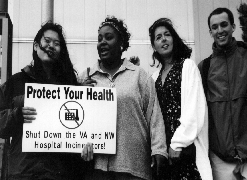Lois Gibbs has been shot at, insulted, threatened and harassed in her twenty one years as an environmental activist. But the mother of Superfund, legislation that seeks to clean up hazardous waste sites around the nation, isnít easily intimidated.
Although people may shoot at me, if they wanted to hit me, they would have years ago. But Iím still fearful that they are bad at missing me, said Gibbs, who established the Center for Health, Environment and Justice in 1981 to help other communities fight for their right to a safe environment. Itís really hard-- [to get over your fears] I was that way at Love Canal but you just have to get up and do it.
 It all started in 1978 when she discovered that her neighborhood in Love Canal, NY was located on a 20,000 ton chemical waste dump. Lois and her husband moved to Love Canal, New York in the mid-seventies to raise their young family and settle in what they thought was a picturesque, working class neighborhood near the Niagara river. Mr. Gibbs worked for Goodyear Chemical Company, and Lois stayed at home with their two infant children.
Gibbs was baffled by the array of illnesses such as epilepsy, asthma, and urinary track infections that hospitalized her children every week, especially because of their healthy family history. When Niagara Falls Gazette reporter Michael Brown published a series about the 20,000 ton chemical waste dump in town, Lois began to realize why her children were sick.
When she learned that her childrenís elementary school was located directly under large amounts of toxic waste, she begged the School Board to move her children to another school. The School Board denied her request because it felt that every student would want to move if one was granted the privilege.
Lois, who had no formal education or prior knowledge of environmental issues, began to ask the government to clean up or relocate residents in 1978. When they refused to listen, she organized her neighbors into the Love Canal Homeowners Association.
They made me mad, and it wasnít a matter of Iím going to go out and do good. I was just furious and frightened, said Gibbs in describing her motivations to fight.
The state of New York closed the local elementary school and purchased the 239 homes closest to the dump. Gibbs fought for two more years until Jimmy Carter delivered an emergency declaration moving nine hundred families out of the area in 1980. Congress also enacted Superfund legislation in December of 1980 to help clean up other toxic waste sites around the nation.
After her ordeal at Love Canal, Gibbs received thousands of calls from people around the nation also facing environmental hazards. In order to help other people, she established CHEJ. I can provide something to people in a way that comes from personal experience I walked the walk and did it, she said.
Her organization teaches community groups and individuals the basics of advocacy such as writing letters, meeting with public officials and talking to corporations. She also helps people understand technical information in environmental studies.
People get inspired by their own actions and all we really do is give them the path and frame it in a way that they see each step as a major victory, said Gibbs.
While Gibbs is proud of her work and the progress of the environmental movement, a big setback for her came in 1988 when the state of New York decided to build low income housing in parts of the once-contaminated Love Canal. Gibbs warned residents that the canal will continue to leak and affect homes, which were sold to mostly young couples below market prices, and peopleís health. Despite her warnings, she has pledged to help people if they get into trouble.
Most of them [people who move in the new homes] I fear for. Some of them will face the same issues as we did, said Gibbs.
Gibbs is also fighting to stop polluters from setting up facilities in minority or low-income neighborhoods. From her experience, she knows that polluters seek out such communities because they are not inclined to fight.
Itís just devastating because here is a community already suffering a number of social ills, then you pollute it, said Gibbs.
She added that many organizations profile a number of poor communities and find out which is least likely to resist in deciding where to build a facility. In one companyís case, it ended up being East Los Angeles because its primarily poor, primarily a community of color. It all started in 1978 when she discovered that her neighborhood in Love Canal, NY was located on a 20,000 ton chemical waste dump. Lois and her husband moved to Love Canal, New York in the mid-seventies to raise their young family and settle in what they thought was a picturesque, working class neighborhood near the Niagara river. Mr. Gibbs worked for Goodyear Chemical Company, and Lois stayed at home with their two infant children.
Gibbs was baffled by the array of illnesses such as epilepsy, asthma, and urinary track infections that hospitalized her children every week, especially because of their healthy family history. When Niagara Falls Gazette reporter Michael Brown published a series about the 20,000 ton chemical waste dump in town, Lois began to realize why her children were sick.
When she learned that her childrenís elementary school was located directly under large amounts of toxic waste, she begged the School Board to move her children to another school. The School Board denied her request because it felt that every student would want to move if one was granted the privilege.
Lois, who had no formal education or prior knowledge of environmental issues, began to ask the government to clean up or relocate residents in 1978. When they refused to listen, she organized her neighbors into the Love Canal Homeowners Association.
They made me mad, and it wasnít a matter of Iím going to go out and do good. I was just furious and frightened, said Gibbs in describing her motivations to fight.
The state of New York closed the local elementary school and purchased the 239 homes closest to the dump. Gibbs fought for two more years until Jimmy Carter delivered an emergency declaration moving nine hundred families out of the area in 1980. Congress also enacted Superfund legislation in December of 1980 to help clean up other toxic waste sites around the nation.
After her ordeal at Love Canal, Gibbs received thousands of calls from people around the nation also facing environmental hazards. In order to help other people, she established CHEJ. I can provide something to people in a way that comes from personal experience I walked the walk and did it, she said.
Her organization teaches community groups and individuals the basics of advocacy such as writing letters, meeting with public officials and talking to corporations. She also helps people understand technical information in environmental studies.
People get inspired by their own actions and all we really do is give them the path and frame it in a way that they see each step as a major victory, said Gibbs.
While Gibbs is proud of her work and the progress of the environmental movement, a big setback for her came in 1988 when the state of New York decided to build low income housing in parts of the once-contaminated Love Canal. Gibbs warned residents that the canal will continue to leak and affect homes, which were sold to mostly young couples below market prices, and peopleís health. Despite her warnings, she has pledged to help people if they get into trouble.
Most of them [people who move in the new homes] I fear for. Some of them will face the same issues as we did, said Gibbs.
Gibbs is also fighting to stop polluters from setting up facilities in minority or low-income neighborhoods. From her experience, she knows that polluters seek out such communities because they are not inclined to fight.
Itís just devastating because here is a community already suffering a number of social ills, then you pollute it, said Gibbs.
She added that many organizations profile a number of poor communities and find out which is least likely to resist in deciding where to build a facility. In one companyís case, it ended up being East Los Angeles because its primarily poor, primarily a community of color.
|
Biography
- Established Love Canal Honeowner's Association in August of 1978.
- On August 2, 1978, the New York State Department of Health closed the local elementary school, and moved 239 residents out of the area.
- Gibbs and her neighbors held two EPA officials hostage until the state agreed to move all residents out of the area.
- Jimmy Carter declared an emergency evacution and moved 900 families out
of of Love Canal 1980.
- Gibbs forms the Center for Health, Environment and Justice to help other
communities fight environmental injustice.
|

 It all started in 1978 when she discovered that her neighborhood in Love Canal, NY was located on a 20,000 ton chemical waste dump. Lois and her husband moved to Love Canal, New York in the mid-seventies to raise their young family and settle in what they thought was a picturesque, working class neighborhood near the Niagara river. Mr. Gibbs worked for Goodyear Chemical Company, and Lois stayed at home with their two infant children.
It all started in 1978 when she discovered that her neighborhood in Love Canal, NY was located on a 20,000 ton chemical waste dump. Lois and her husband moved to Love Canal, New York in the mid-seventies to raise their young family and settle in what they thought was a picturesque, working class neighborhood near the Niagara river. Mr. Gibbs worked for Goodyear Chemical Company, and Lois stayed at home with their two infant children.